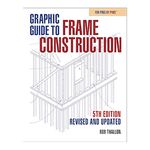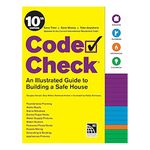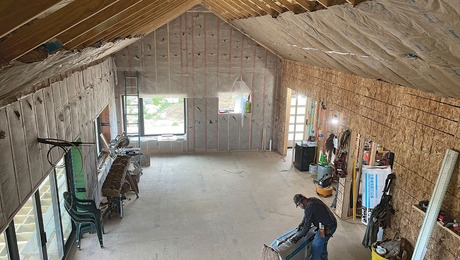In this excerpt from their book Toward a Zero Energy Home, authors David Johnston and Scott Gibson outline the basics of designing a comfortable and durable home.
By rethinking how we design and build the envelope to achieve zero energy, all other decisions like heating, ventilation, and air-conditioning (HVAC) and active solar become less expensive.
From a design standpoint, the guiding force in zero energy homes is solar orientation (specifically, Which direction is south?), which is discussed in detail in chapter 2. If we begin the design process thinking about how we can use the sun to its fullest potential, many other decisions become easier and less expensive. Zero energy homes take advantage of subtle energy flows, such as sunlight turning into heat and how to move that heat inside the building. The building envelope requires very careful design and construction beyond what seemed adequate just a few years ago. Zero energy homes are often 50 percent or more energy efficient than their local energy codes require.
 A super-tight, well-insulated building envelope is the starting point for any zero energy home.
A super-tight, well-insulated building envelope is the starting point for any zero energy home.Building Science 101
Energy conservation in the building envelope is the initial focus for all the zero energy homes featured in this book. Reducing loads—the amount of fossil energy required to provide comfort year round—by half or more makes installing HVAC equipment much more affordable, as a smaller system is needed. Reducing loads requires getting all the building science right, which means understanding how building science principles work in a house: heat flow (thermodynamics), air flow, convection, the stack effect, controlling air with mechanical ventilation, and water flow (hydrodynamics). The key concept here is durability, so the house lasts as long as buildings built by our forebears. A durable home includes strategies for managing water in all forms (liquid, gas, solid), heat loss, heat gain, ultraviolet light, pests, and natural disasters.
Thermodynamics, or how heat moves (from thermo, meaning “heat,” and dynamics, meaning “movement”), is something we are all familiar with, but the basics often escape us when we build. Heat moves from hot to cold—always—even though it may seem that it is the cold that makes us uncomfortable. That is why we call it “heat loss.”
How heat moves
Heat is transferred in three ways: by conduction, convection, and radiation. Conduction is the way heat moves through a solid material. If you put a steel poker into a blazing fire, it isn’t long before it gets too hot to handle. We measure conduction with R-values. The higher the R-value, the greater the resistance to heat flow. Insulation has a better resistance to heat flow than wood. Wood resists heat flow better than metal. Common sense tells us that a hot frying pan with a wood handle can be picked up with bare hands but a cast-iron frying pan needs a pot holder. What has this got to do with construction? Building with steel studs, for example, reduces the effective R-value of a wall assembly by 50 percent.
 To build well, it is critical to involve all the subcontractors in the design process from the beginning. Early collaboration helps prevent problems later in the project.
To build well, it is critical to involve all the subcontractors in the design process from the beginning. Early collaboration helps prevent problems later in the project.Convection is how heat moves through a gas or liquid. Hot air rises, cold air falls. Putting a hand over the flames of a fire lets us know how rapidly the heat can be transferred. Convection is what makes a chimney work. In a house, dense cold air falls, pushing the hot air upward. The air cools and starts to decline again (this is known as a “convective loop”). In a conventional home, air hits a relatively colder window, falls to the floor pushing the warmer air up in the room, and causes drafts. It is what gives us cold feet in winter.
Radiation is how hot bodies transfer heat to colder bodies. We are typically most aware of radiation when standing in the sun on hot days, and we naturally move into the shade when we can. Radiation typically follows line of sight; if we can see a fire, we can feel the heat. If we go around a corner, the heat is not as palpable. In terms of a building, west-facing windows are heated by late afternoon sun, which increases the cooling load of the home in summer.
As simple as these laws of physics seem, they can get very complex inside a house when all three are at work simultaneously. By paying attention to conduction, convection, and radiation at every stage of envelope construction, building high performance houses is more common sense than something exotic.
Air movement
Air leakage is a major problem in most houses. A typical house has 2,000 linear ft. of cracks and gaps that allow air in and out, which can represent up to 50 percent of the heat loss in a building. Often, the older the house, the more air leakage it has. Wherever we join building elements together—bottom plates to subfloor, studs to stud corners, top plates to trusses—there is the potential for air movement through the shell of the building. The designer must be able to identify where this air flow is and how it should be sealed. The air barrier is where outside air is separated from inside air, and there needs to be an air-impermeable separation between the two zones. The air barrier can be toward the inside of the house or toward the outside, depending on climate and selection of building materials.
 Air sealing is a key element in creating a tight building envelope. Using expansion foam is an easy and effective way to seal air gaps.
Air sealing is a key element in creating a tight building envelope. Using expansion foam is an easy and effective way to seal air gaps.Not only does air leakage drain energy from the home but it also often carries moisture into wall cavities or attics, which leads to mold and reduces the lifespan of the house.
The tighter the house, the more important it is to deal with both air and moisture movement inside the building. Air and moisture leakage can be blocked by air barriers and vapor retarders. An air barrier stops the movement of air into and through the cavities of the building. A vapor retarder slows the migration of moisture into the walls and ceilings. A vapor retarder may or may not be the same material as the air barrier. For example, closed-cell spray urethane insulation in rafter spaces provides both an air barrier and a vapor barrier. A wall insulated with fiberglass and wrapped with taped rigid foam insulation has an air barrier on the outside of the sheathing but a vapor retarder on the inside of the wall provided by the drywall and latex paint.
To compound the complexity, as warm air rises, it flows through any vertical holes into the attic, a phenomenon known as the chimney or stack effect. If that warm air contains water vapor, it will find its way into the attic and condense on the colder roof sheathing, sometimes actually raining on the ceiling insulation below. Air sealing needs to start during construction so that all holes between floors are caulked and sealed before the insulation is installed. Electrical, plumbing, and HVAC flues are likely suspects in the first stages of air sealing. Conducting a blower-door test before the drywall is installed can help find remaining major air leaks.
Water intrusion
Air movement and water movement are interconnected and must be considered as the building is being designed. For decades, the building industry has separated the two, which has led to numerous building failures. It has always been the job of builders to keep water out of the house, and typically we depend on the roofer to make sure the house doesn’t leak. But that is dealing only with water, not water vapor or, in extreme conditions, ice. We have to take all three into account to ensure the long life and durability of the house.
 Moisture is the enemy of the building world. A good envelope is designed to shed moisture before it causes problems.
Moisture is the enemy of the building world. A good envelope is designed to shed moisture before it causes problems.Similar to heat, water always flows from higher concentrations to lower concentrations and from warm to cold. If it is more humid inside a house than outside, the pressure will move water vapor through the envelope to the outside. In hot, humid climates with high cooling loads, the pressure will be reversed. This is where air movement and water movement come together. The water vapor is carried in the air, and wherever air can move so can water. To keep moisture out of the wall cavities, it is critical to define the location of the air barrier.
Water vapor control is very climate specific and is determined by the combination of various products (paint, drywall, insulation type, sheathing, drainage plane, and siding). Because air flow is dictated by both temperature and pressure, and moisture is driven by humidity (water moves from wet to dry), vapor retarders in cold climates should be toward the inside of the home. In hot, humid climates the vapor pressure is from the outside in, thus the vapor retarder should be toward the outside. In either case, the wall cavity, if it is able to absorb moisture, wants to dry toward the opposite side of the vapor retarder. Complicated enough?
Water movement from the outside of a house to the inside is one of the major causes of building failure. While a house might be sealed well when originally constructed, over time, building elements can deteriorate. For example, adhesive flashing around windows and doors may work well for the first few years, but eventually adhesion may fail, creating pathways for water to creep around the flashing and into the framing. Mechanical flashing, or ensuring that each layer of housewrap correctly laps over the previous layer, is especially important above doors and windows. Flashing and housewrap should always work together and be lapped from the bottom up, just as roof shingles always lap over each other. Manufacturers of housewraps and window flashings provide detailed installation information, yet most windows are still installed incorrectly.
Going beyond the code
Energy codes, even the 2009 International Energy Conservation Code (IECC) update, are still behind the times. Codes are typically updated every 3 years and then have to be adopted by a local jurisdiction; thus by the time they are adopted they are often 5 years out of date. What assumptions do current energy codes rely on? Oil at $60 a barrel or oil at $147 a barrel?
The energy future we face is so unpredictable that the best way to anticipate it is to design homes that require as little fossil energy as possible. Even if “peak oil”—the point at which oil extraction has reached its maximum—is 10 years away, homes are built to last for at least 30 years and probably more. They will still have to be heated, cooled, and lit, so why build to a code that is based on yesterday’s energy prices? With the uncertainty in energy prices, increased insulation and air sealing can be seen as either cheap insurance or the best investment you can make today. It is the lowest-hanging fruit to save energy that you can put in a building.
 This zero energy home in Washington State was built with advanced framing 2×6 walls and spray-foam insulation.
This zero energy home in Washington State was built with advanced framing 2×6 walls and spray-foam insulation.
Leave a comment here for a chance to win a copy of the book Toward a Zero Energy Home. The winner will be chosen at random on Tuesday, May 18, at 1pm.
Fine Homebuilding Recommended Products
Fine Homebuilding receives a commission for items purchased through links on this site, including Amazon Associates and other affiliate advertising programs.

Homebody: A Guide to Creating Spaces You Never Want to Leave

Graphic Guide to Frame Construction

Code Check 10th Edition: An Illustrated Guide to Building a Safe House























View Comments
Looks interesting. I would happily read the book and comment on it. I would even see if it had any applicability to the historic home I am renovating...
This webpage is a timely discovery for me. We need to downsize and it looks like we'll need to build a small energy efficient place to live in. Started with "A House so Small"? Starting research into what we need and want.
Great primer, I would read and comment. Would be interesting if it will contain practical applications to homes, especially the vast majority of us that live in homes built in the 70's and 80's which seem to have very little of the innovations and "energy" concerns of today.
We just built an energy efficient home. Now I need to figure out how to get off the grid. This book will help a lot.
Someday all my homes will be ZEH. Air sealing insulating is the key....orientation.....we have been offering and implimenting these upgrades for years. Products will become more energywise and more mainstream purchases. Manufacturers are on the fast track with R & D. to replace 19th century products with energywise products without increased cost. Thats when it will explode. I hope to build my first ZEH soon.
I am finally on board for "green energy" after listening to the pros and cons arguments for years. Having the project pay you instead of the other way around is certainly the way to go. The novel idea is way beyond what I could have hoped for. Sign me up.
The authors state that most windows are installed incorrectly. This is not surprising to me, as I see many examples of sloppy work in my own home that was built in 1987. How useful are thermodynamic fine points when the people doing the work don't care or are not trained properly, and doesn't this point out the need for greater attention to these matters by local building inspectors?
Looks like another great book from the authors. I first borrowed from the library and then purchased their previous book, "Green From the Ground Up". I'd love to have a copy of their new book to refer to as we proceed through the design and building process for our new passive solar, super insulated house. With the new house, we are working toward a ZEH by having a good designer who is keyed into the ZEH process, being very involved in the design and construction process and planning to meet with all of the subs so they understand what we want and need in the new house. Our current home is passive solar, super insulated and built with the best technology from 1986. We've enjoyed living here and, most of all, writing very small checks to the propane company each month as compared to our neighbors.
first chapter easy to read, understand. love to see what the rest reads like.
I'm retired and would like to build a house in the next few years. It seems to me a Zero Energy Home (or darn near ZEH) would be the only way for me to go as I don't have the luxury of having my retirement resources keep up with inflation. we know that oil will increase dramatically and Cap & Trade will severely exacerbate that even more.
If we want to be warm in the winter and cool in the summer, we must build much more wisely. Keep the books coming as well as articles like the reality of geothermal heat pumps.
the truth will keep us warm!
PCK
The excerpt from chapter one makes the case for a better built home. Taunton and its contributors certainly know how to do things right. The biggest question I've formed from this is how will the needed specifications make it into the blueprint and what will the pricing for a desireable home become? I am solidly behind moving the art of building into a zero energy home but I am skeptical that one could ever locate all the talents needed for one of these builds. Johnston and Gibson makes the point that methods and processes must change. Provide some tools for organization and I'm in!
I am pressently building an energy efficient home using information that I found in FindHomebuilding. I would certainley read this book an apply any information that would improve on my design. WE will be living off grid so saving energy is important.
I am pressently building an energy efficient home using information that I found in FindHomebuilding. I would certainley read this book an apply any information that would improve on my design. WE will be living off grid so saving energy is important.
As a LEED AP I am always looking for perspectives on energy efficient construction and renewable energy. I will definitely check this book out.
Exactly what we all need to learn more about, and what our building codes need to reflect. The other part of the equation is of course, workmanship...
This is extremely useful for money crunching times like these. It reminds me of another website I've been checking out: http://www.toolbase.org/Home-Building-Topics/zero-energy-homes/zero-energy-home-project